A tessellation is a collection of shapes called tiles that fit together without gaps or overlaps to cover the mathematical plane. The Dutch graphic artist M.C. Escher became famous for his tessellations in which the individual tiles are recognizable motif such as birds and fish.
In Escher's tessellations, the tiles only fit together one way. Following the lead of Roger Penrose, who designed tessellating chickens based on his non-periodic Penrose tiles, Robert Fathauer has designed several sets of tiles that fit together in many different combinations. This features prominently in "Order and Chaos", in which both ordered and disordered regions are realized using the same two types of tiles. The same basic principle is used in "Face to Face" to create a number of distinct faces by varying the orientation of three different types of square tiles.
Another preoccupation of Escher's was his desire to depict an infinite tessellation in a finite print. His best-known attempts at this (his "Circle Limit" prints) are based on hyperbolic geometry, which he learned about from the mathematician H.S.M. Coxeter. Escher made another print, "Square Limit", in which similar tiles (shaped the same, but of varying size) become infinitesimally small at the boundary. This latter print is based on a non-hyperbolic tessellation of triangles.
Aided by an understanding of fractals, which were not widely recognized as a distinct branch of geometry in Escher's lifetime, Robert Fathauer has discovered hundreds of fractal tessellations, most of which have fractal boundaries. He has used these fractal tessellations as the basis for several prints, including "Bats and Owls", "Fractal Fish - Grouped Groupers", and "Migration".
While Escher designed his tessellations on paper, Robert Fathauer designs his directly on a Macintosh computer. Several of Escher's prints play with the fact that his images are only two-dimensional drawings. In "Reptiles", one of his best known works, a reptile leaves a page on which the tessellation is drawn to become part of a three-dimensional scene. Of course, the irony is that the "three-dimensional" scene is also just a flat drawing. In "Chameleons", chameleons leave the tessellation on the computer screen to become part of a three-dimensional scene. Of course, the scene never existed except as a flat image on his computer screen. "Sky and Water in the Digital Age", an homage to one of Escher's best-known prints, plays with the fact that the motifs in Fathauer's tessellations are just collections of pixels. The blurring of the line between sky and water (between the birds and the fish) is accomplished by successively coarsening the pixel resolution of the tiles.
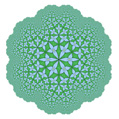

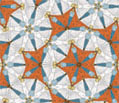



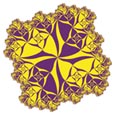

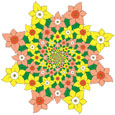

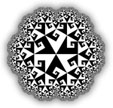



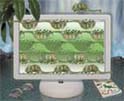

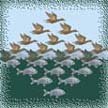



















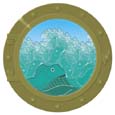

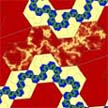











 Click on the thumbnail images to see larger versions with descriptions.
Click on the thumbnail images to see larger versions with descriptions.
